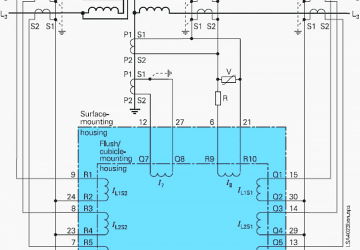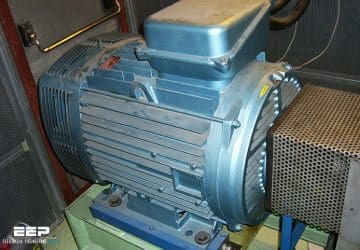How to Protect Capacitor Banks?
Capacitor banks are used to compensate for reactive energy absorbed by electrical system loads, and sometimes to make up filters to reduce harmonic voltage. Their role is to improve the quality of the electrical system. They may be connected in… Read more
Oct 05, 2012 | By Edvard Csanyi

Definitions of Abnormal Voltage Conditions
A sag is a temporary reduction in the normal AC voltage. A momentary sag is a variation, which lasts for a period of 0.5 cycle to about 2 s usually the result of a short circuit somewhere in the power system. Instances… Read more
Oct 02, 2012 | By Edvard Csanyi

What is the difference between Bonding, Grounding and Earthing?
One of the most misunderstood and confused concept is difference between Bonding, Grounding and Earthing. Bonding is more clear word compare to Grounding and Earthing, but there is a micro difference between Grounding and Earthing. Earthing and Grounding are actually… Read more
Sep 27, 2012 | By Jignesh Parmar

Inspection of Ground-Fault Protection Systems
This type of protection is defined by the NEC (National Electrical Code) to ensure protection against fire on electrical power installations. To ensure protection against fire: The NEC defines the use of an RCD with very low sensitivity called GFP IEC… Read more
Sep 25, 2012 | By Edvard Csanyi

Surge Protection of Electronic Equipment
Generally, power circuits have components that have large thermal capacities, which make it impossible for them to attain very high temperatures quickly except during very large or long disturbances. This requires correspondingly large surge energies. Also, the materials that constitute… Read more
Sep 22, 2012 | By Edvard Csanyi

Introduction to Static Protection Relays
The term ‘static’ implies that the relay has no moving parts. This is not strictly the case for a static relay, as the output contacts are still generally attracted armature relays. In a protection relay, the term ‘static’ refers to… Read more
Sep 21, 2012 | By Edvard Csanyi

What is the purpose of equipotential bonding?
Equipotential bonding is essentially an electrical connection maintaining various exposed conductive parts and extraneous conductive parts at substantially the same potential. An earthed equipotential zone is one within which exposed conductive parts and extraneous conductive parts are maintained at substantially… Read more
Sep 20, 2012 | By Edvard Csanyi

Functions Performed by Electrical Switchgear
National and international standards define the method for making electrical distribution circuits as well as the purpose and functions of switchgear. There are three main functions, namely: Circuit protection takes three main fault types into account: Overloads, Short-circuits (Both of which… Read more
Sep 14, 2012 | By Edvard Csanyi

Transformer differential protection (ANSI 87T)
Transformer differential protection protects against short-circuits between turns of a winding and between windings that correspond to phase-to-phase or three-phase type short-circuits. If there is no earthing connection at the transformer location point, this protection can also be used to… Read more
Sep 05, 2012 | By Edvard Csanyi

Motor protection depending on size and voltage level
Motor protections vary widely depending on the size of the motor and voltage level involved, thus only the more common ones are discussed in this technical article. Index Motor Instantaneous Over-current Protection Motor Timed Over-Current Protection Thermal OverLoad Motor Ground… Read more
Aug 30, 2012 | By Edvard Csanyi

High resistance grounding equipment in mining applications
High resistance grounding equipment or permanently installed electrical distribution systems used in mines should be selected and applied as recommended for process industries. When mobile equipment is connected to the distribution system the grounding equipment and the ground fault protection should be designed… Read more
Aug 22, 2012 | By Edvard Csanyi

Protecting Oil Type Transformer with Buchholz Relay
Buchholz relay is a gas-actuated relay installed in oil immersed transformers for protection against all kinds of faults. Named afteri ts inventor mr. Max Buchholz (1875–1956) in 1921, relay is used to produce an alarm in case of incipient (i.e.slow-developing) faults… Read more
Aug 16, 2012 | By Edvard Csanyi

Delayed Auto-Reclosing On EHV Systems
On highly interconnected transmission systems, where the loss of a single line is unlikely to cause two sections of the system to drift apart significantly and lose synchronism, delayed auto-reclosing can be employed. Dead times of the order of 5s-60s are commonly used…. Read more
Aug 11, 2012 | By Edvard Csanyi

Principles of Transformers in Parallel Connection
For supplying a load in excess of the rating of an existing transformer, two or more transformers may be connected in parallel with the existing transformer. The transformers are connected in parallel when load on one of the transformers is… Read more
Aug 06, 2012 | By Jignesh Parmar

Sizing and protection of the neutral conductor (2)
Continued from the first part – Sizing and Protection of the Neutral Conductor (1) If the neutral conductor is correctly sized (including harmonics), no specific protection of the neutral conductor is required because it is protected by the phase protection. If… Read more
Jul 31, 2012 | By Edvard Csanyi


